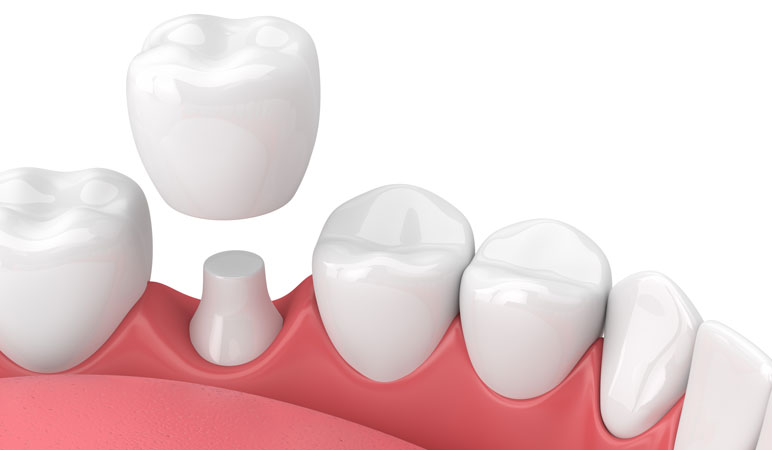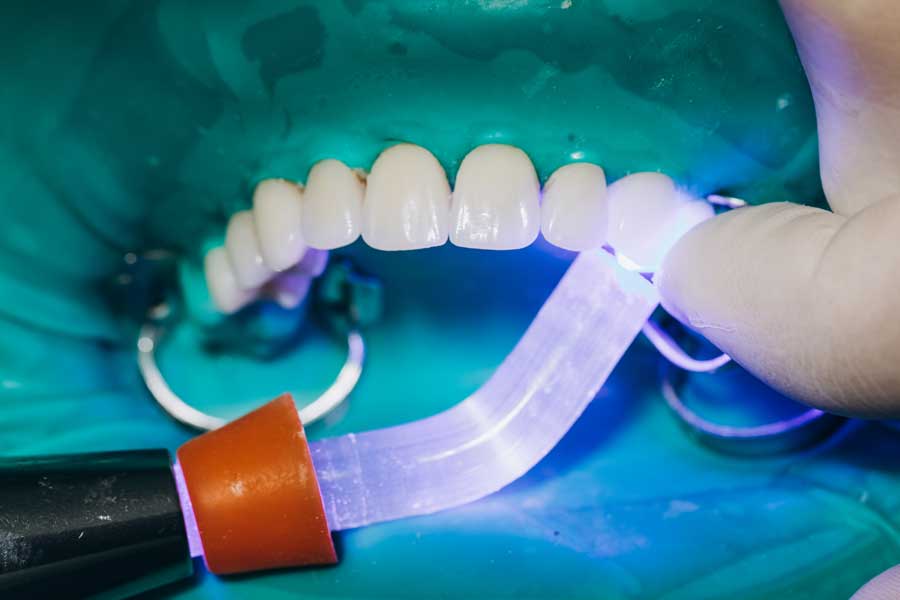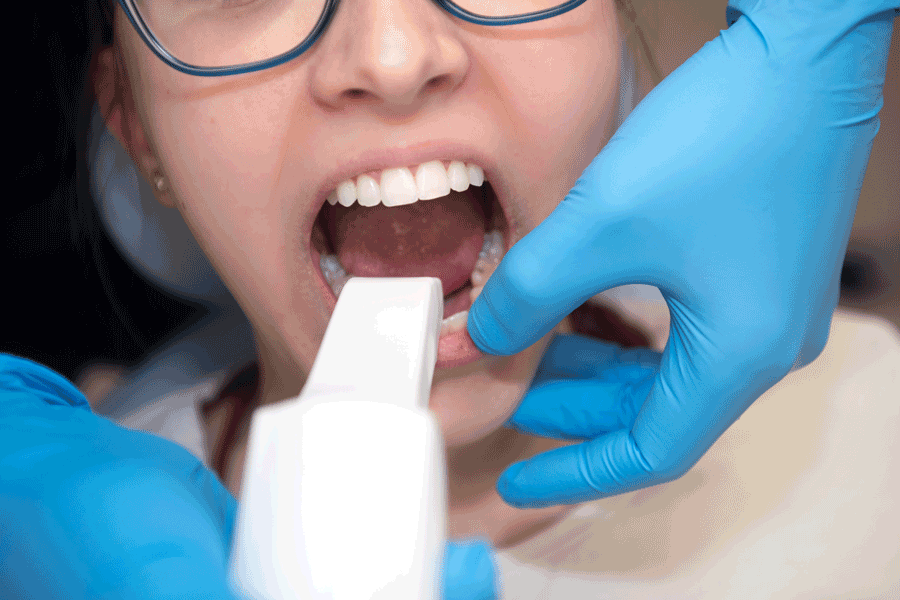Dental Crowns Overview
Over time, your teeth may get worn down or damaged. It may be caused by anything from tooth decay, injuries, or just normal wear and tear.
An artificial cap (or "crown") is used to cover up a cracked or decayed tooth. Crowns strengthen teeth by restoring their shape, size, strength and appearance back to its previous condition. Crowns protect, cover, and restore the shape of teeth when fillings aren't enough to solve the problem. A Dental Crowns is typically made from metal, ceramic, porcelain, or composite materials. They usually require no special care but just follow normal oral hygiene practices and your crown will appear naturally.

Why Is a Crown Needed?
We offer consultations at our Stafford based clinic, get in touch to determine if a dental crown treatment is the right solution for you. Contact us now!
-
Proactive maintenance
To prevent a weak tooth from breaking off completely a crown maybe used to aid replair.
-
Fix a damaged tooth
To fix a damaged, chipped, or cracked tooth, you may be able to use dental crown.
-
Prevent further decay
You could prevent further tooth decay if you fill any cavities before they start growing into larger ones.
-
Improve your smile
If you want to cover up badly shaped or heavily stained teeth
-
Cosmetic recontruction
You want to make a cosmetic change.
What Types of Crowns Are there?
In most cases there are 5 principle materials that are used to make a crown, each have their own advantages and of course costings.
Prefabricated (or prefab) crowns are made from metal and are usually used for a short period of times before they’re replaced by a permanent crown. If there’s damage to any part of the tooth, then a temporary crown covers the entire tooth so that none of its parts remain uncovered.
Crowns made from metals including alloys containing gold, platinum, or base metal alloys (such as cobalt-chrome) may be considered for patients who require extensive restorative procedures but who cannot afford porcelain veneers. Crowns made from metal are strong enough to resist biting and chewing forces and may be able to outlast others for longer periods of time. Crowns made from metals usually don't chip or crack. Gold has its drawbacks too; for example, the metallic color and the high cost of buying one. Crowns made from metal are a good option if they're not visible.
Ceramic-on-ceramic dental crowns can match their neighboring tooth colors better than metal ones. Metal or resin crowns last longer than porcelain crowns but they're not as comfortable for chewing. If the crown chipped or broke off, the porcelain part could be damaged too. Porcelain fused to metal (PFM) crowns closely resemble natural tooth enamel.
Sometimes the metal underneath the crown shows up as a darker line when viewed from above; however, most people don't notice this unless their teeth are extremely stained. Crowns can be used for both front and back teeth as well as longer bridge restorations where they're needed for support.
Dental crowns made from resin are cheaper than others. They're not quite as durable as porcelain fused to metal crowns but last longer than cast gold crowns.
Ceramics offer superior natural tooth appearance compared to porcelains, which means they're less likely to show through when you smile. They also tend to last longer because they don't wear down as quickly as porcelains. Porcelains, however, require special care to keep them looking good. Ceramics can be used for both front and back teeth.

Book Appointment
Temporary Crown vs Permanent Crown.
Temporaries can usually be made at your local dentist's office; however, most permanent crowns are normally made by a lab technician or organisation. A typical temporary crown is usually made from an acrylic-based material (or stainless steel) and can be used for a short period of time before a permanent one needs to be fabricated.
It’s just a temporary solution until you get a permanent one. You're going to wear it for a short period of time before it is replaced with a permanent dental crown or alternative solution.
You'll need to go back to see your dentist again after placing the temporary crown for another appointment. Your dentist will remove the temporary crown and replace with a permanent one.
What Steps Are Involved in Preparing a Tooth for a Crown?
A typical dental procedure consists of an initial examination followed by preparation of the teeth (the removal of decayed tissue) and then finally placing a temporary crown until the final crown has been placed.
When visiting your dentist at his/her office, they may wish to examine the teeth/ tooth again closely by taking several x-ray pictures (XRays) to see if there are any cavities or fractures. Root canal treatments are usually recommended for teeth with severe decay or when there is an increased chance of damage to the tooth's pulp (the soft tissue inside).
Anesthesia is used as it numbs the tooth and surrounding tissues before they're cut away during preparation for crowns. Afterward, the tooth receiving the restoration is shaped along its chewing surfaces and sides so there's enough space for the restoration.
Depending on which kind of crown you use, the amount of material that needs to be removed varies. If part of a tooth has been lost due to decay or damage, then your dentist may fill the hole using dental cement to strengthen the remaining structure.
In some cases your dentist depending on the treatment required may also take a scan of your teeth for shape & fitment purposes.

Once the tooth has been shaped by the orthodontist, he/she may use a special material called "putty" to create an impression of the tooth so that they can later take impressions for making the final crown. Sometimes, however, an impression is made by using a digital camera. Your dentist will take impressions of both the upper and lower teeth so they know exactly where to place the crown so that it does not negatively affect your bite.
When the impressions are taken at the dentist’s office, they're sent to a dental laboratory for manufacturing purposes. Your crowns usually come back to your dentist's office within 2–3 weeks. Your dentist may choose the best match for the surrounding teeth when selecting the shade of porcelain used to create your new crown/s. Acrylic crowns are typically used for short term use (usually less than two weeks). They're often placed into position by applying a thin layer of dental adhesive onto them and then placing them directly onto
Your dentist will take off the temporary crown at your next appointment so he/she can see if the new one fits properly. A local anesthetic will be applied to numb the affected tooth before its replacement is placed into position. It’s then permanently cemented in place using dental adhesive.
Questions & Answers
Temporary dental crowns are usually used for cosmetic purposes; therefore, they're not meant to last long. Most dentists recommend taking certain precautions when using them. Here are some examples:
- Some people might find chewing gum, caramel, etc., difficult because their teeth aren't strong enough to chew them properly. If this happens to you, don't use these foods.
- Don't chew hard foods (like raw veggies) because they might cause the tooth to crack or chip off.
- When using dental floss to clean between your teeth, slide rather than pull it back and forth so as not to remove the temporary crown.
What problems can occur with a crown?
After having a Crown, you might feel some sensitivity initially because the anaesthesia has worn off. If the crowned tooth still has a nerve inside it, then you might feel some pain when eating hot foods or very cold foods. Your dentist may recommend that you brush with toothpaste designed specifically for sensitive teeth. If you feel pain or sensitivity when biting down, then the crown may be too high on the tooth (or there could be another problem). If this happens, then call your dentist immediately! It’s easy to fix.
A crown may become sensitive when exposed to hot or cold foods or drinks.
If your tooth feels extremely sensitive to pressure when you're biting down, then there might be an issue with the position of the crown or the way it fits together with your other teeth. Discuss with your Dentist, he/she may need to alter the position of the crown or adjust the height, if this is possible.
Porcelain crowns may occasionally crack. Small chips can be fixed by repairing them and the crown can stay in your mouth. You may need to replace the Dental Crown if the chip grows larger or when there are many chips.
Crowns made from porcelain tend to chip more easily than crowns made from gold or silver. If you're having trouble keeping your teeth clean due to a crack, your dentist might be able to repair it with a crown.
Porcelain-fused to metal (PFM) crowns are made from two pieces of ceramic material fused together using heat and pressure. If there’s no damage to the chip itself, then these chips don't need to be fixed.
If the cement holding up the crown gets washed away, then the crown may come loose. Its important to alert your dentist of a loose crown as soon as is possible, as a loose crown will often allow bacteria to get in behind which will cause decay to the tooth that remains. If your crown feels too tight, call your dentist for an appointment.
Dental crowns don't always stay put. If this occurs, it means there was either an incorrect size or too few cements used during installation. Don't wait until something bad happens before contacting the dental clinic where you received treatment. You must follow your dentist’s instructions carefully when caring for your teeth and crown. If there’s no tooth decay underneath the crown, then he might be able to replace or re-seat the entire crown. If not a new crown will need to be made & placed accordingly.
You may use see a dark line next to the gum line of your dental crow, if you’ve had your crown for a long period of time.

